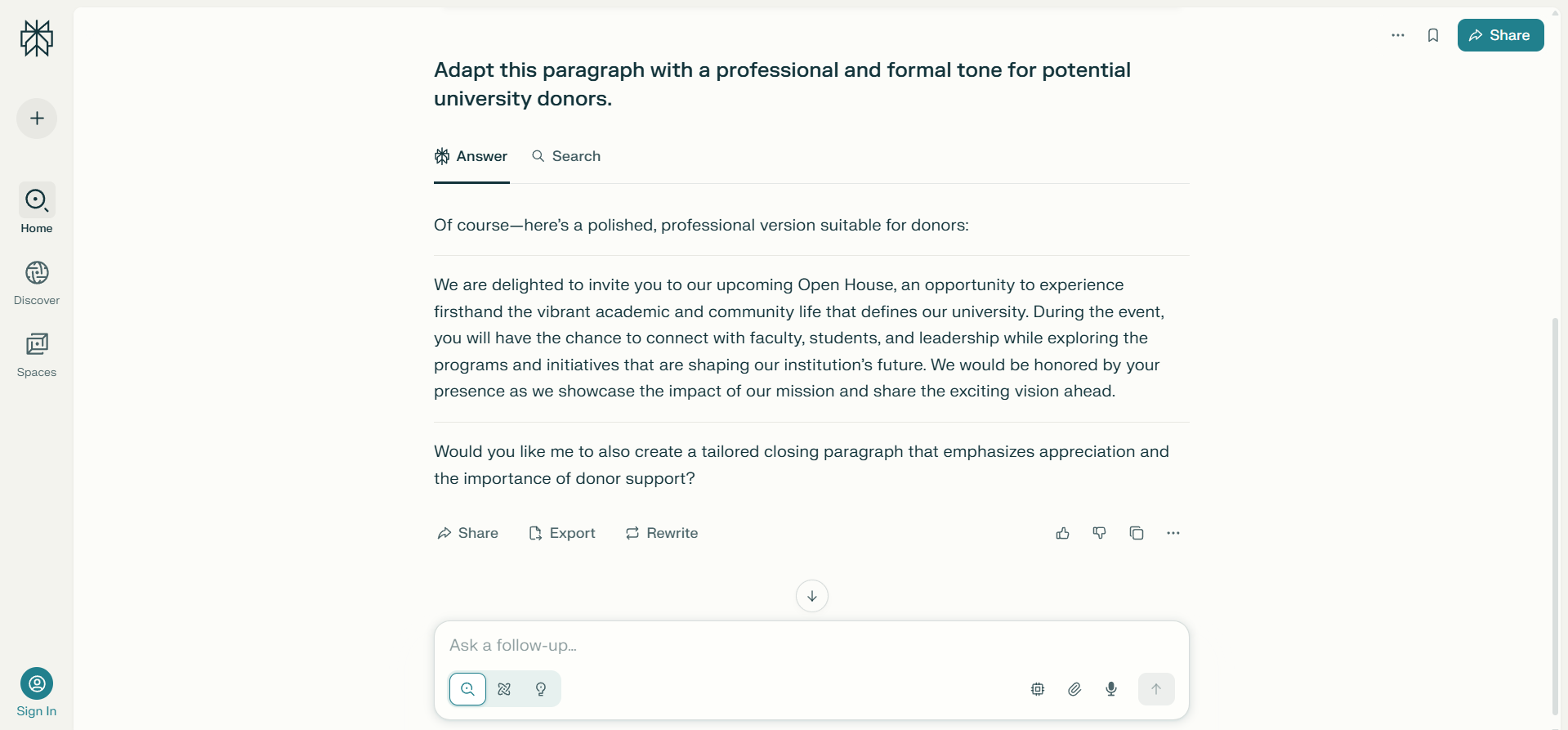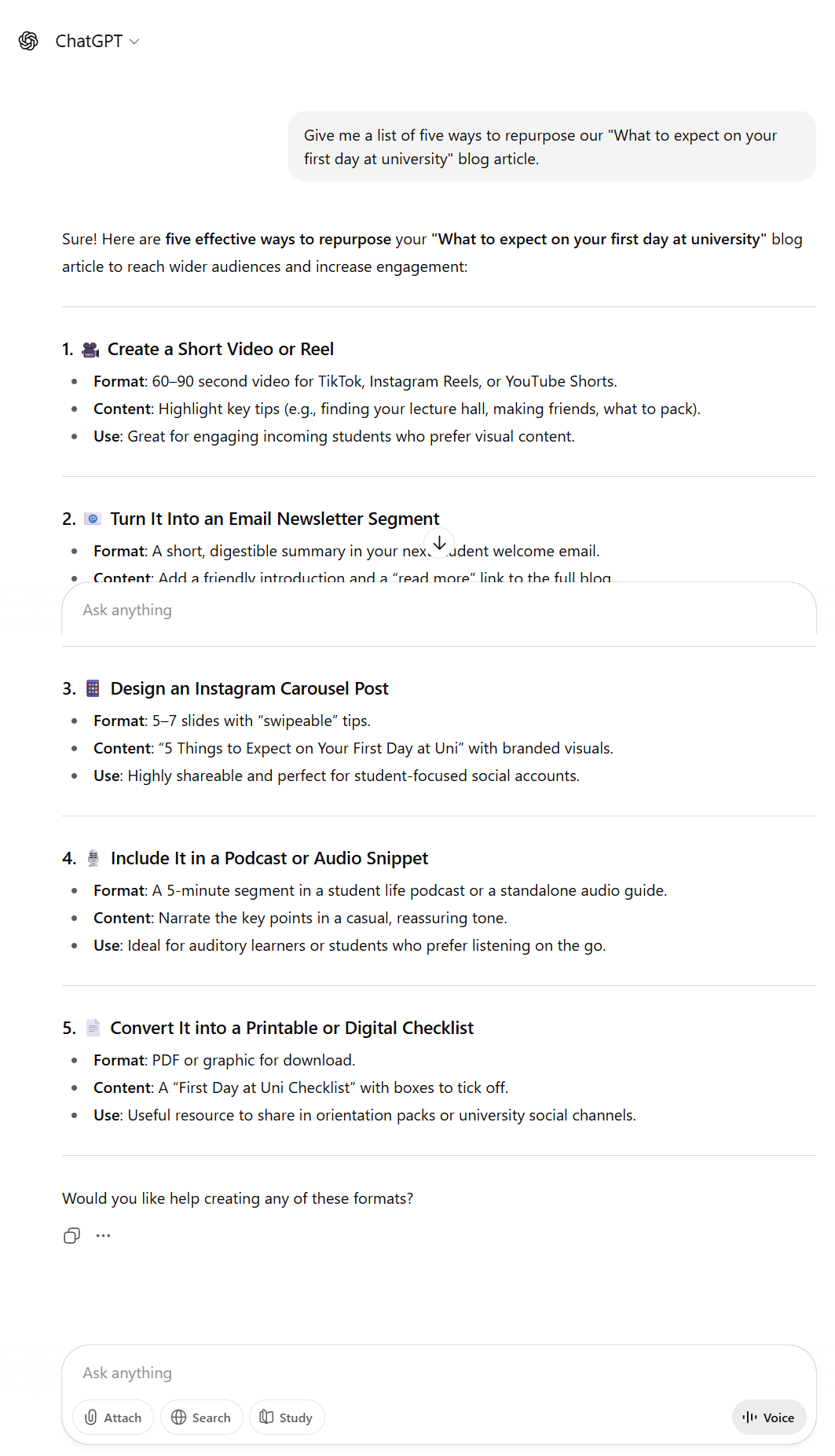We've all been there before: the blank screen or page waiting for input, the "simple-but-catchy" email subject line that isn't quite so simple to write, the ominous clock reminding us that deadlines are fast approaching.
Higher ed marketers need to produce content. Whether it's a short social media post announcing an upcoming open house or a fresh landing page introducing new professional development programs, words play a big part in their daily workflow.
It would be great if every marketing team had skilled copywriters who could craft engaging, informative, and persuasive copy whenever it's needed.
But the reality is that higher ed marketers are sometimes an "army of one" and, in bigger teams, are often under pressure.
So if you haven't used them yet, try out AI-writing assistants, such as ChatGPT, Jasper, and Claude, which can fill your content creation and ideation gap.
When coupled with proper human oversight, here are seven practical ways you can speed up your workflow with an AI-writing assistant:
1. Repurpose content
You know that digital brochure that you have for a program or course? It could be doing a lot more.
Instead of treating it as a one-off, imagine generating multiple content types—a blog article, a dozen social media posts, a recruitment email, a YouTube video script—from that single source document.
Repurposing content isn't new, but AI makes it faster and less resource-heavy. An AI-writing assistant can significantly reduce the effort of manually rewriting and reformatting content for various platforms and audiences.
Here's how to do it in practice:
- Summarize long-form content: Extract the key points from a lengthy document and create several concise social media posts or informative PowerPoint slides.
- Elaborate short-form content: Transform bullet-point notes of a team brainstorming session into a polished blog post or landing page.
- Adapt tone and style to audience: Reframe a formal briefing or presentation to key decision-makers into a series of student-friendly, fun social media posts.
- Restructure and reformat: Break down a long blog article into short captions for social media, an email teaser, or a script for a YouTube video.
- Generate multiple versions for testing: Create variations of an email subject line or webpage copy for A/B testing purposes.
2. Personalize and localize marketing messages
Higher ed marketers communicate with a diverse audience: existing students, prospective students, parents, educators, industry professionals.
AI-writing assistants can customize marketing messages to cater to different segments, addressing their specific interests, goals, concerns, and pain points.
You can even provide your AI tool with any available demographic (e.g., age, gender, locations, education) and psychographic (e.g., interests, values, attitudes, lifestyles, motivations) data to build detailed personas from which your AI-writing assistant can use to craft narratives that resonate with them.
For example, the same program announcement can be framed differently depending on the audience.
Students may respond to messaging that emphasizes career prospects and flexible scheduling.
Employers will be more interested in how the program helps them upskill their workforce through industry partnerships.
Parents are likely to value reassurance that the program balances academic quality with strong career outcomes for their students.
This kind of personalization not only increases campaign effectiveness but also strengthens your institution's reputation as relevant, supportive, and attuned to the needs of different stakeholders.


Use Perplexity to create two versions of the same e-blast opening paragraph:
one that's fun and casual for prospective students
and another that's formal and professional for potential donors.
3. Use AI to boost search visibility
Search visibility is critical, but not every higher ed marketing team has an SEO expert on staff.
Your AI-writing assistant can help you identify keywords and long-tail phrases that matter most to your audience and integrate them naturally into your content.
From blog posts and online newsletters to website and landing page copy to meta descriptions, you can optimize copy for both search engines and readers.
So, if you don't have the time or inclination to learn how to use robust SEO-dedicated tools, such as Ahrefs or SEMrush, an AI-writing assistant is a great alternative.
Use it to identify valuable keywords, long-tail variations, optimal keyword density, and even guide placement across headings, body copy, and calls to action to increase search engine visibility and improve rankings.
4. Brainstorm ideas
Even the best higher ed marketers hit creative roadblocks.
Whether you're a novice or seasoned writer, an AI-writing assistant is an invaluable tool to spark new content ideas—or give life to old ones by looking at them from different angles.
Think of it as an interactive swipe file, a collection of proven collateral—clever copy snippets, eye-catching designs and logos, unique magazine spreads, effective email subject lines and calls-to-action, impactful slogans and taglines—that marketers, writers, and designers use for inspiration.
Now imagine having a "conversation" with your swipe file. Instead of flipping through examples, you can ask AI to suggest blog topics, draft opening lines, or reshape a clunky outline.
The goal isn't to replace your judgment but to keep ideas flowing.
This type of conversational "thinking out loud" will definitely put you on the right track with a first draft when you're stuck and unsure of your approach.

ChatGPT can help you brainstorm various ways to maximize your content's potential by repurposing a popular blog article and adapting it for other media and channels.
5. Generate foundational copy
Your college and university subject matter experts (SMEs) are already stretched thin, balancing recruitment campaigns, enrollment priorities, and events.
Expecting them to also draft basic content isn't realistic. But foundational content is still required.
That's where AI can help. An AI-writing assistant can generate foundational content that's essential but time-consuming.
Think of things like:
- Clearer definitions of general higher ed and institution-specific terminology.
- FAQs for prospective and current students, parents, alumni, faculty, and staff.
- Standard identity copy, such as "About us" and the institution's history.
- Course, program, and degree information. It excels at making these approachable.
- Campus and student services overviews.
- Routine student communications (e.g., welcome and onboarding messages, deadline reminders, and special event announcements).
6. Using AI as a second pair of eyes: Asking for feedback
Sometimes you just need feedback before hitting publish.
Besides generating content and ideas, AI-writing assistants are wonderful tools for advice and edits.
It won't replace a skilled copy editor, but it can help you spot issues you might miss when you're working under pressure.
You can prompt your AI-writing assistant to review your copy and provide feedback on:
- Grammar, spelling, punctuation, and word choice
- Clarity, conciseness, and flow
- Document and paragraph structure
- Repetition, cliches, and industry jargon
- Platform and channel optimization
- Originality and plagiarism
- Brand adherence
- Optimization for web platforms, including headers and metadata

Asking Gemini for feedback on a first draft will give you a helpful critique
and suggested revisions to improve your original copy.
7. Keep your brand voice consistent
Consistency builds trust.
Prospective students, alumni, and partners should recognize your institution's personality no matter where they encounter it—on your website, in an email, or on social media.
You can train your AI-writing assistant to help you maintain that brand cohesion and match your college's or university's unique tone and style.
Provide it with examples of your best-performing content and, if available, your brand voice guide.
This way, you can generate copy that feels on-brand from the start, saving you time on rewrites and ensuring your messaging aligns across channels.
Here are some elements worth feeding into your AI assistant:
- Your institution's image: List adjectives that best describe your college's or university's desired personality (e.g., inspiring, supportive, innovative, approachable, sophisticated, quirky, down-to-earth).
This personality will contribute to the overall tone of your brand voice and copy. - Styles and standards: Adherence to an industry-standard style book (e.g., Chicago Manual of Style, Associated Press Style, Modern Language Association Style) or an in-house style guide ensures all content conforms to a single set of rules, such as Oxford commas, heading and title casing, contractions, bullet point conventions.
- Target audience(s): Describe who you're writing to—current and prospective students, alumni, donors, faculty, industry partners—and how your brand voice can be adapted for each.
- Scenario-based voices: Make sure the content's tone matches the context.
For example, a formal and serious tone when seeking support from donors vs. a fun and casual tone on social media posts about upcoming graduation events. - Institution terminology: Is your student support department called "Student Services" or "Student Affairs"? Are students aided by academic "advisors" or "counselors"? Do new students go through "orientation" or "onboarding"?
Whatever terminology you prefer, use it across all your content and platforms.
Importance of human oversight
AI-writing assistants are invaluable tools to support higher education marketers' content efforts, but they're not replacements for human judgment and ingenuity.
They can help you move faster, repurpose content, and generate ideas—but they can't replicate the intuition, empathy, and institutional knowledge that higher ed marketers bring to the table.
While they can significantly increase workflow efficiency and content quantity, AI-generated copy should never be sent or posted as-is without strict human oversight.
It takes a human familiar with the nuances of your institution's values to inspire others to feel the same. And it takes a human with emotional intelligence to understand the needs and concerns of a diverse audience to truly engage.
Used well, AI-writing assistants become 24/7 creative partners in your higher ed marketing toolkit, doing the heavy lifting so you can focus on strategy, storytelling, and connecting with people.
Are you using an AI-writing assistant? How have you integrated it into your HE marketing efforts? Let us know in the comments on social media.

:format()//media/AI-writing-tips-for-higher-education-rq.png)